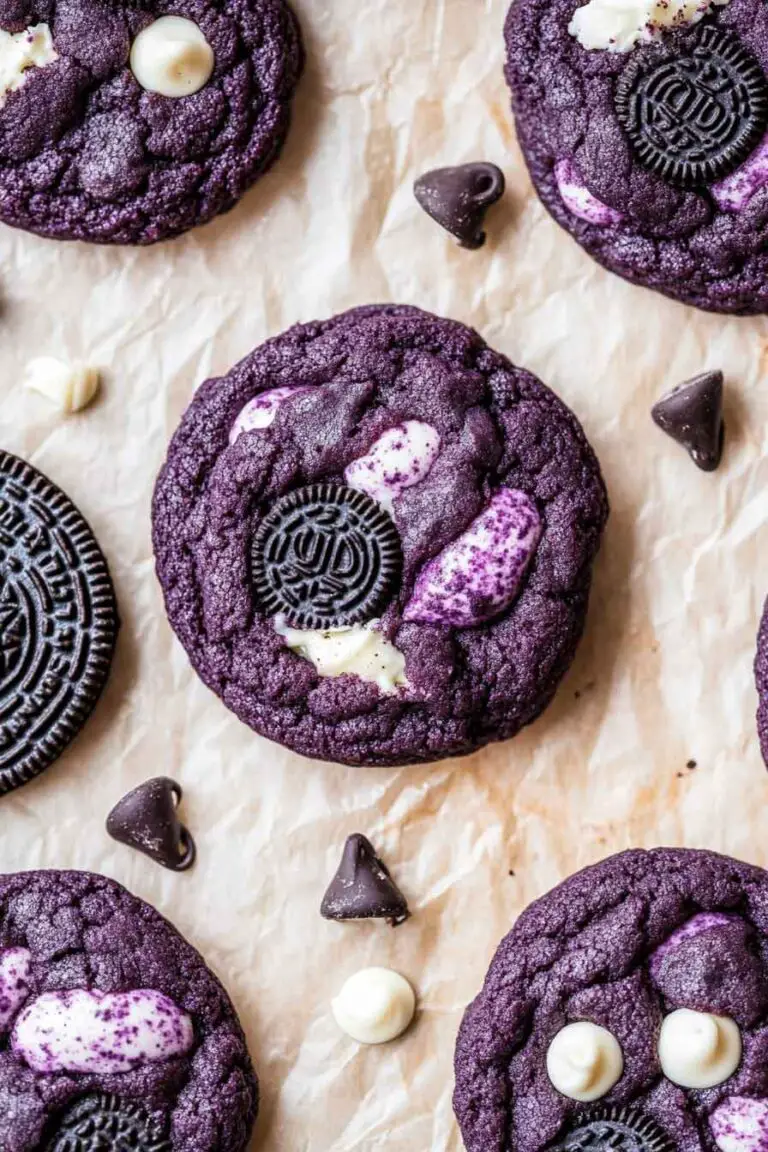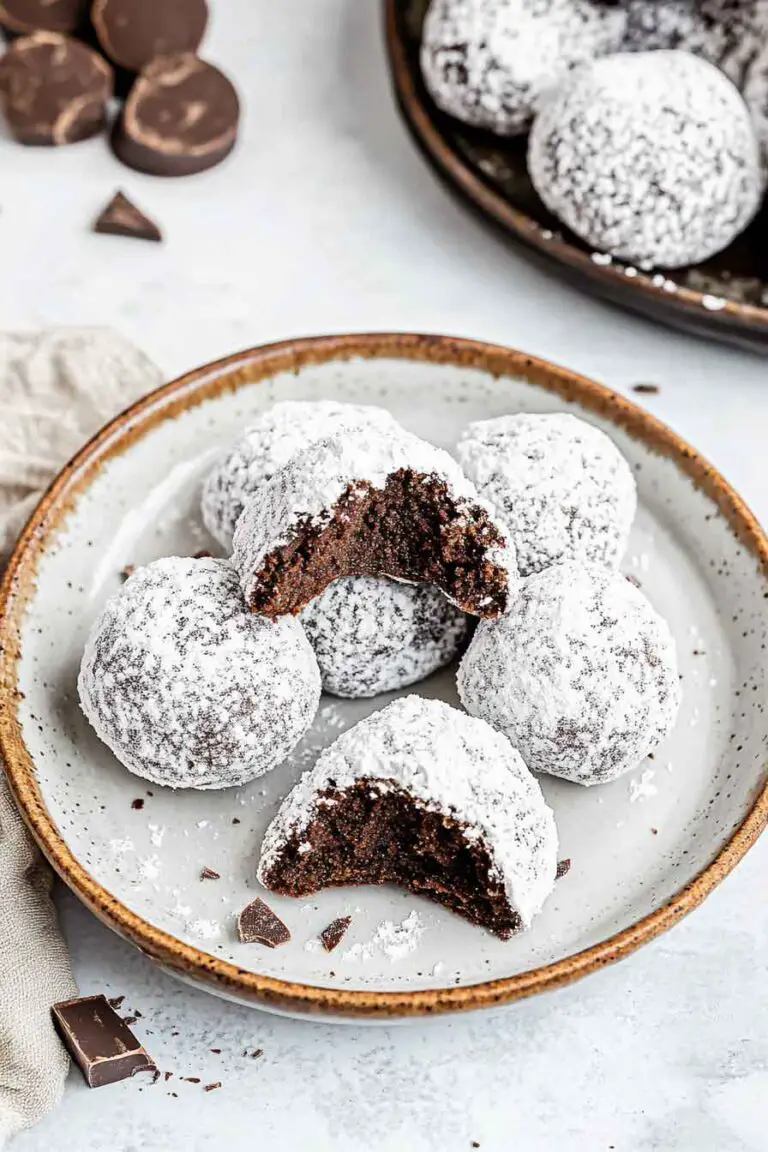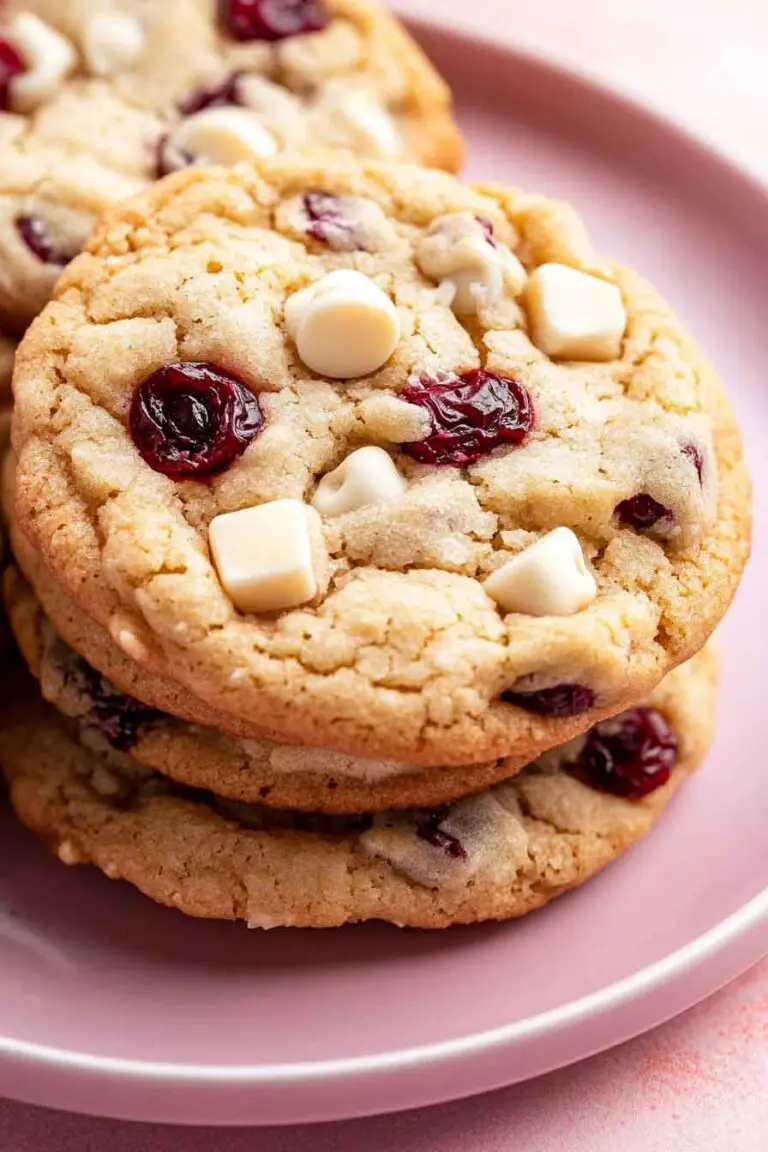Soft Citrusy Orange Cookies
These Soft Citrusy Orange Cookies are bright, sweet, and full of sunshine. They’re soft in the middle, with a light crisp edge and a fresh orange zing. One bite and you’ll taste the real citrus flavor—it’s the kind that makes you smile.
I first made them on a rainy day, just to bring some brightness into the kitchen. The orange zest makes them smell amazing, and the soft texture keeps them from lasting long on the plate. They’re simple, but feel special every time.
Perfect for spring, brunch, or anytime you want something light and fresh. I’ll show you how I make them step by step. You’re going to love how soft and citrusy they turn out.
Why You’ll Love This Recipe
- Soft and Buttery Texture: These cookies are soft through the center with slightly crisp edges. Butter provides a rich base, while the sugar keeps the crumb tender.
- Balanced Citrus Flavor: The fresh orange zest gives the dough an aromatic burst, while the juice adds natural acidity and subtle tang. Unlike lemon, orange provides a rounder, warmer citrus note.
- Made with Everyday Ingredients: No fancy or seasonal products required. You probably already have everything you need—except maybe a fresh orange.
- Subtle and Not Overpowering: These cookies are mild enough for kids and appealing to adults who enjoy less sugary desserts. The citrus flavor doesn’t dominate; it complements.
- Elegant with a Simple Glaze: A quick orange-sugar glaze brushed or drizzled over the cookies adds a glossy finish without making them overly sweet or sticky.

What You Need to Know Before You Start
Prep & Bake Schedule:
Prep Time: 20 minutes (active)
Chill Time: 30 minutes (for dough to firm up)
Bake Time: 10–12 minutes per batch
Total Time: About 1 hour and 10 minutes
Servings:
This recipe yields approximately 24 medium-sized cookies (1.5 to 2 tablespoons of dough each), enough for about 6 to 8 servings depending on portion size. The recipe doubles easily for a crowd.
Skill Level:
Beginner-friendly. You don’t need any advanced baking techniques here. The most important steps are measuring the flour correctly (spoon and level), zesting without digging into the bitter white pith, and not overbaking the cookies. They’re supposed to stay soft and pale in the center when pulled from the oven.
Required Kitchen Tools
Before you begin, make sure you have these tools ready. These are common in most home kitchens:
- Mixing Bowls: At least two—one for the dry ingredients and one for creaming the wet ingredients.
- Stand Mixer or Hand Mixer: A hand mixer works just fine; this dough is soft enough not to require a stand mixer.
- Citrus Zester or Microplane: This helps you zest only the orange peel, not the bitter white pith underneath.
- Citrus Juicer or Reamer: A handheld citrus squeezer or reamer extracts juice quickly. Fresh juice is key to flavor.
- Rubber Spatula: Useful for folding in the dry ingredients without overmixing the dough.
- Baking Sheets and Parchment Paper: Line your pans to prevent sticking and promote even browning.
- Cookie Scoop (1.5 to 2 tbsp): Ensures evenly sized cookies for consistent baking.
- Wire Cooling Rack: Allows airflow under the cookies as they cool, preventing sogginess.
Ingredients for Soft Citrusy Orange Cookies
Each ingredient plays a specific role in both texture and flavor. Here’s a deeper breakdown of what you’ll need (exact measurements appear in the Recipe Card):
- All-Purpose Flour: The base of the dough. Too much will make the cookies dry, so spoon it into your measuring cup and level it off with a knife.
- Baking Powder: This leavening agent gently lifts the cookies, giving them a pillowy center. Unlike baking soda, it won’t make them spread too much.
- Salt: Just ¼ to ½ teaspoon is enough to bring out the sweetness and deepen the orange flavor. It’s a small detail that makes a big difference.
- Unsalted Butter: You want the butter soft but not melted—about 65°F. This allows it to cream well with the sugar and trap air for a tender texture.
- Granulated Sugar: Sweetens and helps the butter cream into a light, fluffy mixture. White sugar also encourages a cleaner citrus taste than brown sugar.
- Large Egg: Binds everything together and contributes to the structure. Bring it to room temperature for even mixing.
- Fresh Orange Juice: Avoid bottled—fresh juice gives a brighter and more complex flavor. One medium orange should yield enough juice.
- Fresh Orange Zest: Zest adds concentrated orange oil that can’t be replicated with juice alone. Zest your orange before juicing it, not after.
- Confectioners’ Sugar (for Glaze): Dissolves easily with orange juice to create a thin glaze that sets softly on top of the cooled cookies.
Variations for Soft Citrusy Orange Cookies
These cookies are versatile enough to handle small changes while still delivering that signature citrus-forward profile. Here are a few thoughtful variations to consider:
- Add a Vanilla Note: Mix in ½ teaspoon of pure vanilla extract to soften and balance the citrus edge. It rounds out the flavor without distracting from the orange.
- Swap Citrus: Lemon or grapefruit zest and juice can be used instead of orange for a slightly different twist. Each brings its own kind of brightness.
- Use Orange Extract: For a more intense orange flavor, add ⅛ teaspoon of orange extract—but go easy. It’s potent and can easily overpower.
- Add Mix-ins: White chocolate chips, dried cranberries, or even chopped pistachios can be folded into the dough for texture and contrast.
- Make Them Vegan: Replace the egg with a flaxseed egg (1 tablespoon ground flax + 2.5 tablespoons water) and use plant-based butter.

How to Make Soft Citrusy Orange Cookies
Step-by-Step Instructions
1. Whisk Dry Ingredients
In a medium bowl, whisk together the all-purpose flour, baking powder, and salt. Set this aside so it’s ready when you need it. This step evenly distributes the leavening agent and prevents overmixing later.
2. Cream the Butter and Sugar
In a large mixing bowl, beat the softened unsalted butter with the granulated sugar using a hand or stand mixer on medium speed. Beat for 2–3 minutes until the mixture is pale and fluffy. This step creates air pockets in the dough, which helps the cookies bake up light and tender.
3. Add the Egg, Orange Juice, and Zest
Crack in the egg and beat until fully combined. Then add the fresh orange juice and zest. Beat again on low just until everything is incorporated. The mixture may look slightly curdled at this stage, which is normal because of the citrus juice reacting with the butter—it will smooth out when you add the dry ingredients.
4. Mix in the Dry Ingredients
Add the flour mixture gradually, beating on low speed just until no dry streaks remain. Use a spatula to scrape the bowl and gently fold the dough. Be careful not to overmix. The dough should be soft and slightly sticky.
5. Chill the Dough
Cover the bowl and refrigerate the dough for at least 30 minutes. This firms it up and prevents the cookies from spreading too much in the oven. If chilling longer (up to 2 hours), allow it to rest at room temperature for 10 minutes before scooping.
6. Scoop and Bake
Preheat your oven to 350°F (177°C) and line baking sheets with parchment paper. Scoop the dough into balls about 1.5 tablespoons each and place them 2 inches apart.
Bake for 10 to 12 minutes, or until the edges are barely golden and the centers look just set. Do not overbake—these cookies continue to firm up as they cool.

7. Cool and Glaze
Allow the cookies to cool on the baking sheet for 5 minutes before transferring to a wire rack. Once fully cooled, drizzle or brush them with a thin glaze made from confectioners’ sugar and fresh orange juice. Let the glaze set for 10–15 minutes before storing or serving.
Serving and Decoration
These cookies are best enjoyed the same day they’re baked, when the outer edges are slightly crisp and the center stays soft. The subtle orange glaze gives them a polished look without overpowering sweetness.
Serving Ideas:
- With Tea or Coffee: A mild black tea or lightly roasted coffee makes a perfect pairing.
- For Brunch Tables: Add a tray to a breakfast spread alongside scones or fruit.
- As Gifts: Their delicate citrus flavor and soft color make them ideal for gifting during spring and summer holidays.
Optional Garnishes:
- Sprinkle extra zest on the glaze before it sets for more aroma and visual interest.
- For a festive twist, dip half of each cookie in melted white chocolate and sprinkle with sanding sugar or crushed candied orange peel.
Storing Soft Citrusy Orange Cookies
Room Temperature:
Store cookies in an airtight container at room temperature for up to 3 days. To maintain softness, layer them with parchment paper and place a slice of bread in the container.
Refrigeration:
These cookies don’t require refrigeration, but if glazed heavily or if your kitchen is very warm, chilling can help them stay fresh longer.
Freezing:
You can freeze unglazed cookies in a freezer-safe bag or container for up to 2 months. Thaw at room temperature, then glaze just before serving.
Tips and Tricks for Success
As an experienced baker, I’ve tested this recipe many times. Here are a few practical tips that will help you get consistently soft, flavorful results every time:
- Use Fresh Zest, Not Bottled Flavorings: The zest carries essential oils that bring real orange aroma. Always zest the orange before juicing—it’s harder the other way around.
- Don’t Skip the Chill: Chilling the dough helps control spreading and enhances the texture. Even 30 minutes makes a noticeable difference.
- Avoid Overbaking: The cookies should look slightly underdone in the center when you take them out. They’ll firm up as they cool, keeping their soft texture.
- Measure Flour Correctly: Spoon the flour into your measuring cup and level it with a knife. Scooping directly from the bag can pack in too much flour, making cookies dry.
- Optional Double Zest: If you love bold citrus, zest two oranges instead of one. Just keep the juice amount the same.

Nutrition
Here is an approximate nutritional breakdown per cookie (based on 24 cookies total):
| Nutrient | Amount per Cookie |
|---|---|
| Calories | 140 kcal |
| Total Fat | 6 g |
| Saturated Fat | 3.8 g |
| Cholesterol | 20 mg |
| Sodium | 60 mg |
| Total Carbohydrate | 20 g |
| Dietary Fiber | 0.3 g |
| Total Sugars | 10 g |
| Protein | 1.5 g |
| Vitamin C | 4 mg |
| Calcium | 8 mg |
| Iron | 0.5 mg |
Note: Nutrition will vary depending on specific brands and glaze amount used.
Soft Citrusy Orange Cookies
Course: Cookie Recipes20
minutes10
minutes140
kcal30
miniutesIngredients
2 and 1/4 cups (281g) all-purpose flour (spooned & leveled)
1 and 1/2 teaspoons baking powder
1/2 teaspoon salt
3/4 cup (170g) unsalted butter, softened
3/4 cup (150g) granulated sugar
1 large egg, at room temperature
2 tablespoons fresh orange juice
1 tablespoon fresh orange zest
1/2 teaspoon pure vanilla extract (optional)
- For the Glaze:
1 cup (120g) confectioners’ sugar
2–3 tablespoons fresh orange juice
Additional orange zest, optional
Directions
- Whisk Dry Ingredients:
In a medium bowl, whisk together flour, baking powder, and salt. Set aside. - Cream Butter and Sugar:
In a large bowl, beat butter and granulated sugar together on medium speed for 2–3 minutes until light and fluffy. - Add Wet Ingredients:
Beat in the egg, followed by the orange juice and zest (and vanilla if using). Mix until combined. The mixture may look slightly curdled. - Mix in Dry Ingredients:
Add the flour mixture in two additions. Mix on low until just combined. Do not overmix. - Chill the Dough:
Cover and refrigerate for 30 minutes to firm up the dough. - Preheat and Scoop:
Preheat oven to 350°F (177°C). Line baking sheets with parchment paper. Scoop dough into 1.5 tablespoon-sized balls and place 2 inches apart. - Bake:
Bake for 10–12 minutes or until the edges are set and bottoms are lightly golden. Centers may look soft. - Cool:
Allow cookies to cool on the baking sheet for 5 minutes, then transfer to a wire rack. - Glaze:
In a small bowl, whisk together confectioners’ sugar and orange juice until smooth. Drizzle over cooled cookies. Garnish with extra zest if desired. - Let Set:
Allow the glaze to set for 10–15 minutes before serving or storing.
Soft Citrusy Orange Cookies FAQs
Can I make the dough ahead of time?
Yes. The dough can be prepared up to 2 days in advance and stored in the refrigerator. If it becomes too firm, let it sit at room temperature for 15 minutes before scooping.
Can I freeze these cookies?
Absolutely. Freeze unbaked cookie dough balls on a tray, then store them in a freezer-safe bag for up to 2 months. Bake from frozen, adding 1–2 extra minutes to the bake time.
Do I have to glaze the cookies?
The glaze is optional but recommended. It adds a soft sheen and extra citrus flavor. If you prefer a less sweet finish, skip it or dust lightly with confectioners’ sugar instead.
Can I use bottled orange juice?
Fresh juice is best. Bottled juice lacks the brightness and depth of fresh-squeezed, and it often includes preservatives that affect flavor and consistency.
Why are my cookies dry?
This usually happens from overbaking or using too much flour. Be sure to measure flour by spooning it into the cup and leveling it. Pull the cookies from the oven when the centers still look soft.
Conclusion
These Soft Citrusy Orange Cookies bring a light, refreshing twist to traditional home baking. They’re simple to prepare, full of natural flavor, and perfect for just about any occasion. Whether you’re sharing a plate at brunch, sending a care package, or baking with kids, these cookies deliver warm citrus comfort without being too sweet or heavy.
With minimal ingredients, fresh orange, and a soft crumb that stays tender for days, this recipe is a staple worth repeating. If you’ve never added citrus to your cookie rotation, this is a great place to start.









